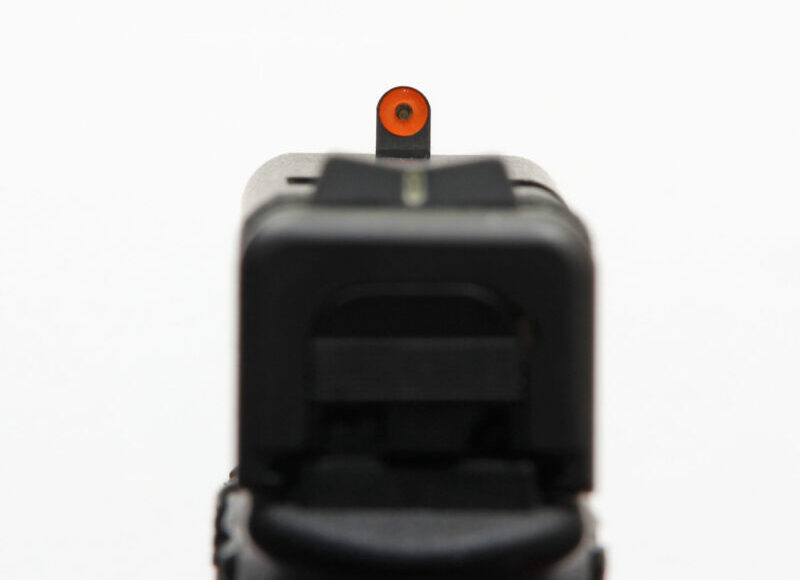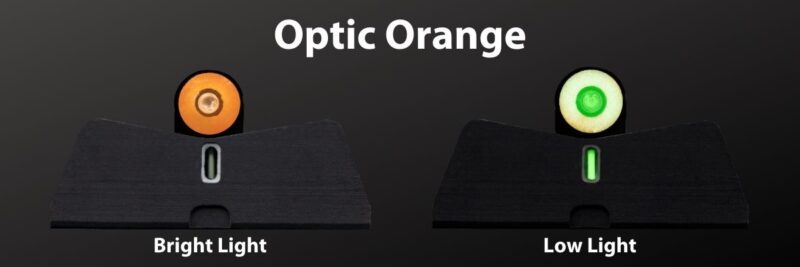17
XS Sights DXT2 Night Sights
Stack The Odds In Your Favor
I remember the first time I saw oversized “express” sights on a pistol. The pistol belonged to the late, great Louis Awerbuck. I still don’t remember the particulars of the firearm, but I sure remember the shockingly large front sight.
Louie was explaining some concept or another to a dullard of a student (i.e., me) during a class. He produced his own pistol to demonstrate the concept, and my eye immediately caught what appeared to be a ping-pong ball sitting on the front of the slide. When I quizzed him about it, the understated Mr. Awerbuck simply said it was so he could see the front sight in order to shoot people who needed shot.
What he had shown me that day about 30 years ago was one of the first Big Dot pistol sights. It opened my eyes to a different way of looking at pistol sights (puns intended).
At the time, I was ten feet tall, bulletproof and equipped with a better-than-average set of peepers. Obviously, I didn’t need such assistance — I thought — even though I intuitively understood how the oversized sight could be useful for fast target acquisition.
Fast-forward to my first set of XS Sights Big Dots about 5 years ago. As part of doing a story, I installed a set on one of my GLOCK concealed-carry guns and held up it to my eye. “WHOA, Nelly!” The worm had definitely turned for me.
At the time, I was fighting with a problem — the front sights on most guns had become fuzzy. I believe it was a communist plot or the result of Global Warming, even though other shooters claim they hadn’t noticed the same thing. Meanwhile, especially in low light, my split times were increasing as it took longer and longer to find the aiming button on the front of the gun — probably the communists at work again.
However, from my first look through a set of XS Big Dot Sights, I was a believer. The front sight was still a bit fuzzy without the help of reading glasses, but overall, I had a much easier time lining up on target. I got a bit faster and even my accuracy got better. I can’t say the new sights improved my smile or made my whites whiter, but they definitely enhanced my skills and — more importantly — my confidence went up.
History
“Express” sights have been around since people started using guns to pester large dangerous animals in Africa. Hunters quickly realized a blade or Patridge sight was difficult to see at tag-your-it distances in the bush when something huge was bearing down, intent on rearranging you into something resembling a pile of rare-done tomahawk steaks.
The first express sights were large beads of ivory, though one common field-expedient method involved tying a white cloth around the muzzle. I’ve heard it claimed warthog ivory was best because it didn’t yellow in the weather. These big beads of white stood out nicely against incoming danger and kept many a 19th-century nimrod from pushing up daisies at the hands of “Savage Brutes” (the animal kind).
Fast forward to the early 1990s when big-brain gear designer and avid shooter Ashley Emerson saw the advantages of doing the same with a pistol sight. I’m pretty sure Mr. Awerbuck was carrying a prototype of what was later offered by Emerson’s company, Ashley Outdoors.
In 1997, Emerson and Ed Pastusek formed A&E Manufacturing, which went through several name changes and eventually morphed into XS Sights. Today, it has grown to be the best source of Big Dot aftermarket sights.
Anatomy of a Big Dot
The sights are just what the name says: a larger-than-“normal” dot on the front mated to a wide, shallow-V rear sight. While there are a variety of sighting systems of varying measure, the DXT2 is approximately twice the size of comparable sights.
XS Sights offers two colors for the front dot: Optic Yellow and Optic Orange. I’ve got both, and both seem equally useful to me though XS says Optic Orange offers better contrast against most backgrounds in natural light, while the Optic Yellow glows the brightest in low light. Both are worlds better than stock sights or even standard tritium night sights.
With the 10-year lifespan tritium capsule centered in the middle of the front DTX2, so long as you can identify a target, you’ll have a sight picture. In fact, you’ll have a big, glowing, impossible-to-miss dot superimposed on your target. The rear sight uses a vertical tritium capsule wherein you “Dot-the-I” to align, thus preventing confusion as sometimes happens when trying to line up the typical three dots of other night sights in very low light conditions. When you have a bit more light, putting the yellow or orange “golf ball” atop the wide-V rear is about as quick as it gets with iron sights.
The sights are built from solid steel and blued, while the orange and yellow coating is chemically resistant to acetone-based cleaners and ultrasonic baths. One nice touch is the convex surface of the dot makes it easy to wipe off powder residue and other flotsam.
The sights are easy to install on most guns so long as you have the necessary tools and a rear-sight pusher. Of course, XS makes a great sight pusher for GLOCK and other installation tools.
Some internet commandos claim accuracy suffers when using Big Dot sights, and they’re probably correct — when you’re back at 50+ yards. However, at bad-breath distance, I’ll take the tradeoff in speed every time. I’ve also seen good shooters demonstrate hits at 100 yards using a Big Dot, so it’s more about the loose nut behind the gun rather than the sighting system.
Final Thoughts
It’s simple: If you have aging eyes, you absolutely need XS Sights DXT2 Big Dot Night Sights for your carry guns. If you don’t have aging eyes, you still need DXT2 sights because it will decrease the time it takes to find the all-important bump on the end of the gun and line up the shot.
Regardless of your age or skill level, if you want to maximize your chances of surviving an armed encounter with your CCW handgun, you can significantly push the odds onto your side of the ledger simply by installing a set of DTX2 sights. For more info, visit XSSights.com.






